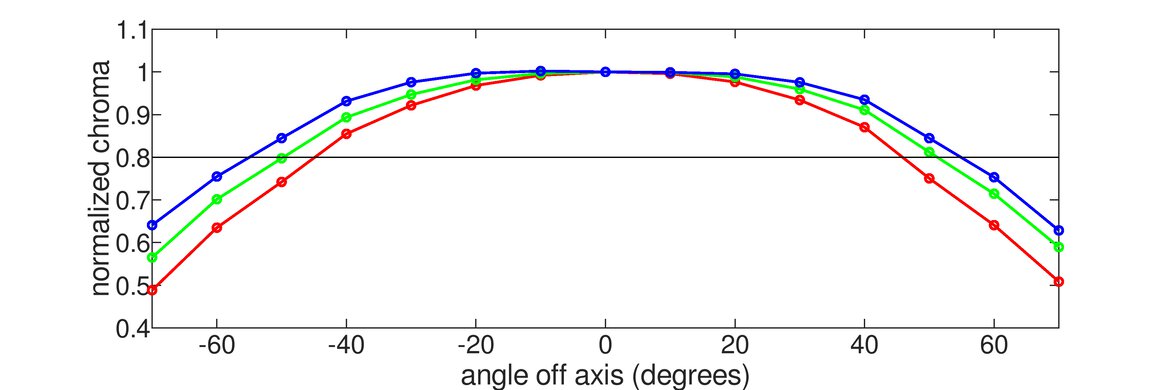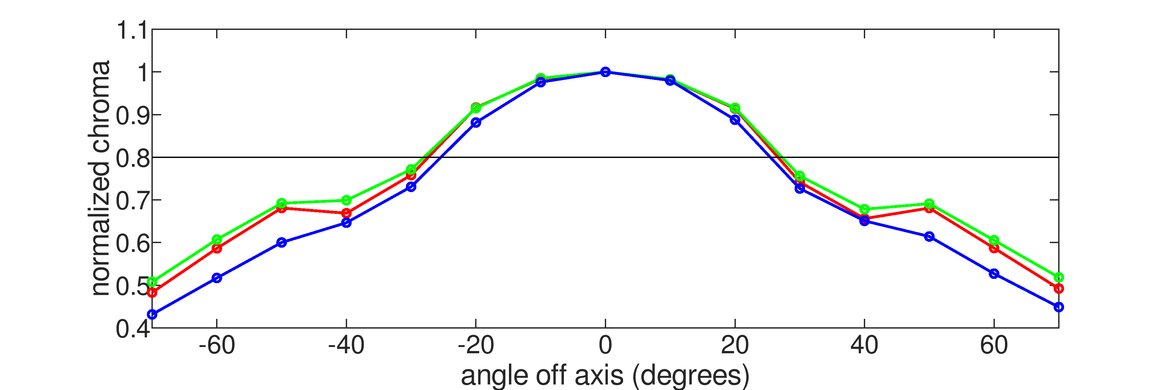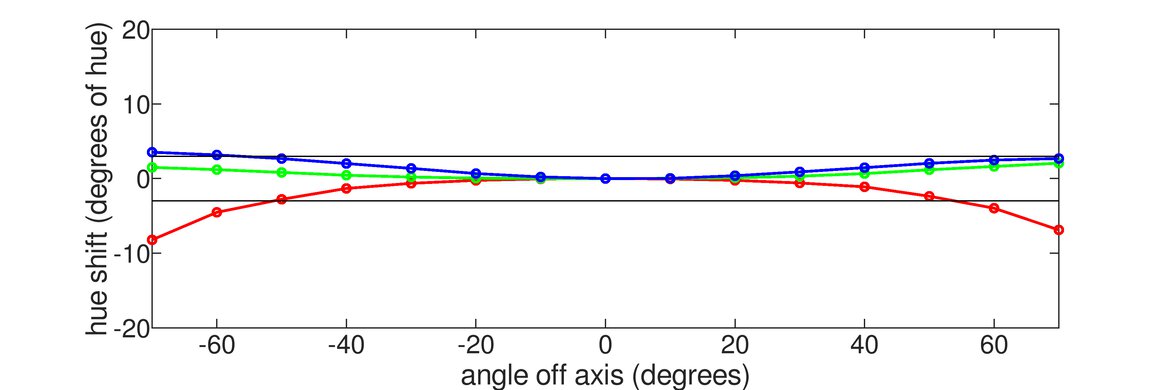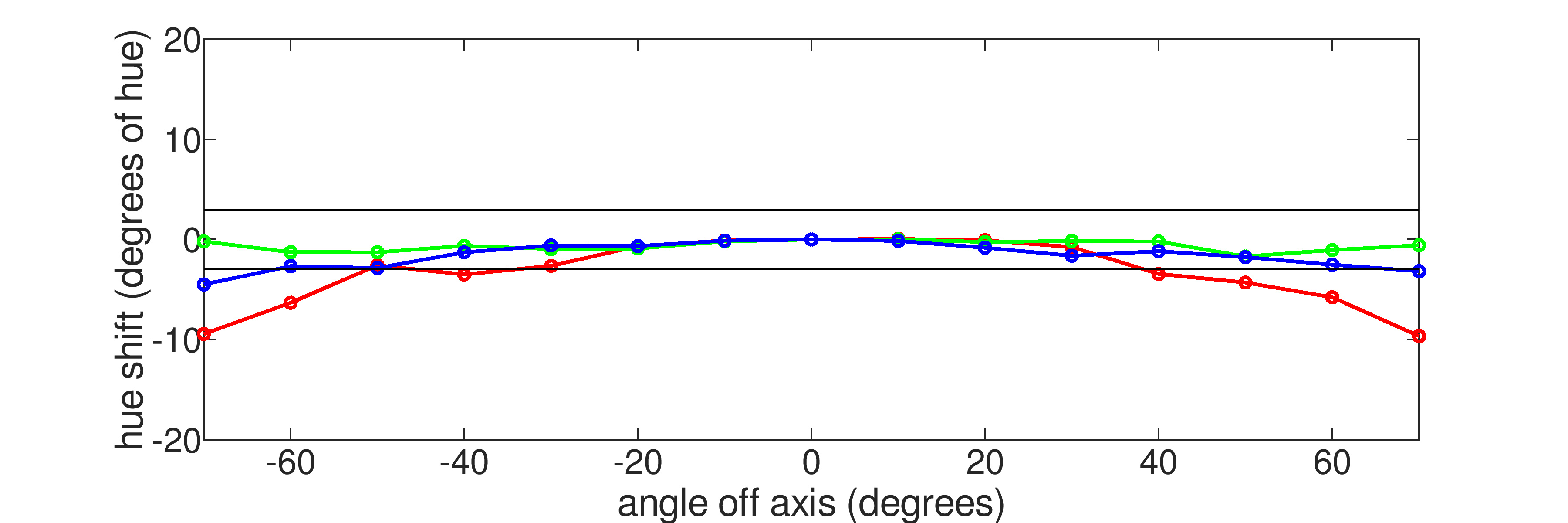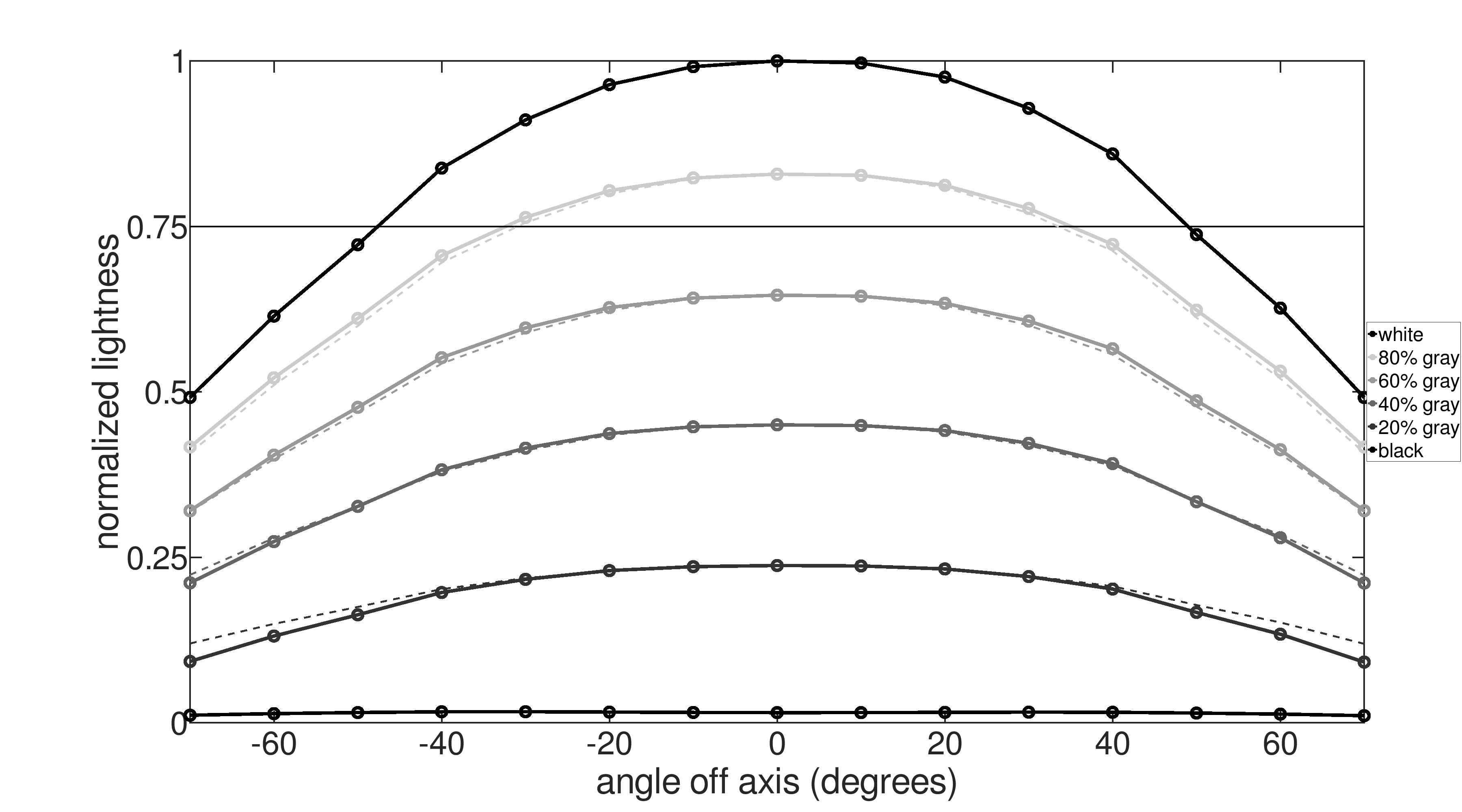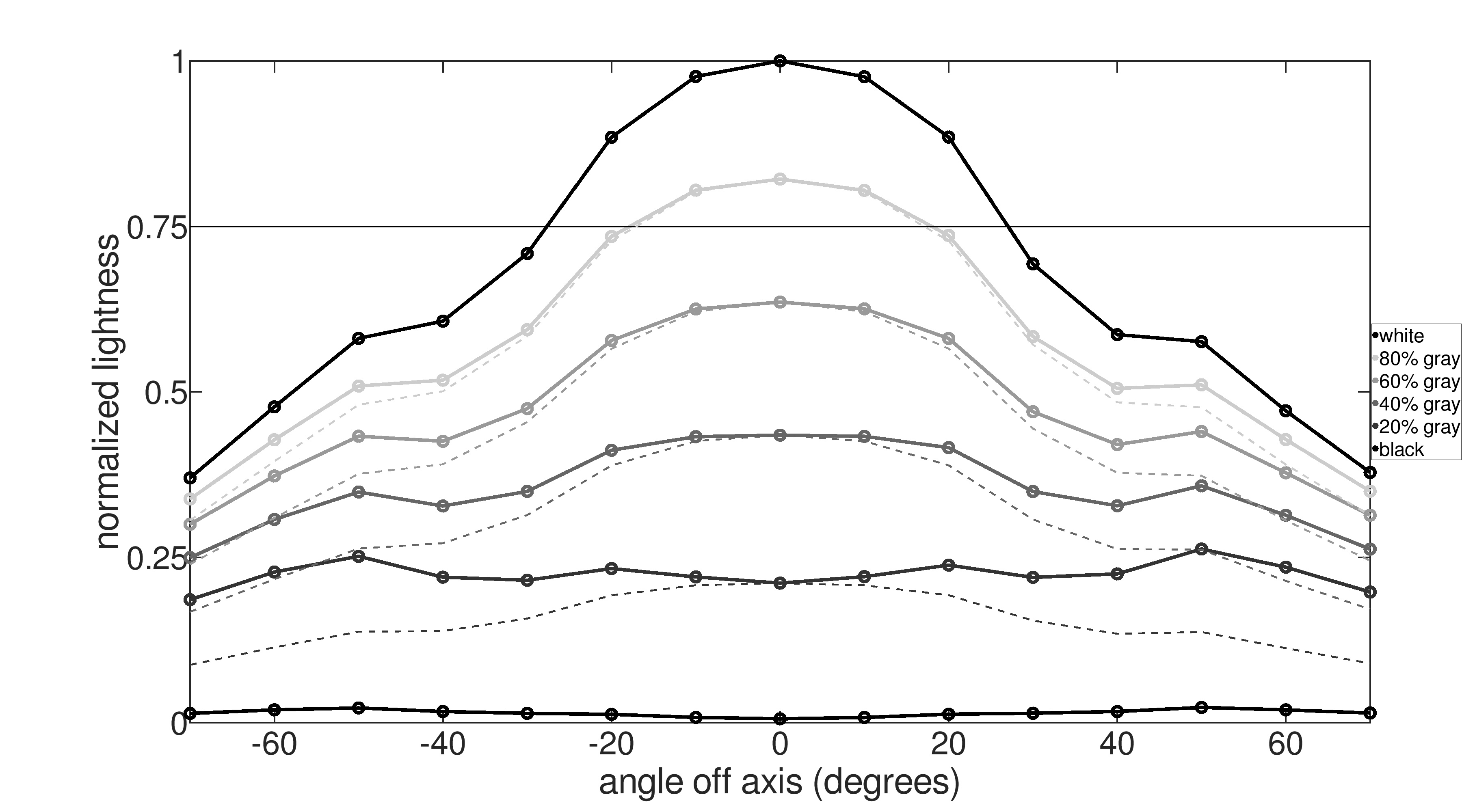- Table of Contents
- Intro
- When It Matters
- Our Tests
- Additional Information
- Conclusion
- Comments
Our Monitor Picture Quality Tests
Horizontal Viewing Angle
- 2.5% Color Washout From Left
- 2.5% Color Washout From Right
- 2.0% Color Shift From Left
- 2.0% Color Shift From Right
- 3.0% Brightness Loss From Left
- 3.0% Brightness Loss From Right
- 2.0% Black Level Raise From Left
- 2.0% Black Level Raise From Right
- 3.0% Gamma Shift From Left
- 3.0% Gamma Shift From Right
Horizontal viewing angles have a massive impact on the way we look at displays. Whether we've realized it or not, images from your monitor don't look the same when you're looking at it directly in front versus when you're looking at it from the side. Viewing angles affect how accurate the image remains as you move off-center. It's important to have good viewing angles on a monitor if you need to share your screen with someone else or if you sit very close to the screen. The type of panel your monitor has also impacts the horizontal viewing angle.
We test for a variety of picture quality aspects when looking at horizontal viewing angles, and unlike TVs, we also test for vertical viewing angles, which you can read about here. If you also want to learn more about TV's viewing angles, see here.
Test results
When It Matters
Horizontal viewing angles affect the way we see an image, either when we're viewing from the sides of the monitor or if we sit too close. A monitor with wide horizontal viewing angles means the image remains accurate when viewing from an angle. Also, if you have a large monitor like an ultrawide, the edges of the screen remain accurate if you sit up close. However, a monitor with narrow horizontal viewing angles causes the image to look inaccurate or washed out when viewing from the sides, and if you sit up close, the left and right edges appear darker.
Having a monitor with good viewing angles is important if you need to share your screen with others around you, as you both need to see the same, accurate image. It's less important if you're just showing a document - the whites might look different - but if you're a photo editor or content creator, it's crucial to see accurate colors wherever you sit.
Our Tests
Although our tests for horizontal viewing angles get into detail about different aspects of the picture quality, it's easy to see the effects of viewing angles for yourself at home. If you look at any display at an angle, whether it be your monitor, TV, phone, or tablet, does the image look noticeably different from when you're viewing it from directly in front? If you don't notice any difference, it means the display has wide horizontal viewing angles. Most phones and tablets have wide viewing angles because we look at those displays from a variety of positions. Many LED TVs and some monitors have narrow viewing angles, so if you walk around the display, you'll notice how the colors start to change or the image looks darker.
In terms of testing, we use a colorimeter to measure changes in color, brightness, black level, and gamma when the monitor is at an angle. We use a Colorimetry Research CR-100 Colorimeter, which is calibrated to the monitor, and then it measures the color, brightness, black level, and gamma at different angles. The results and graphs are automatically generated in the Octave software. However, we also record a video to visually see the viewing angles, which is easier to understand than the graphs. We measure with the colorimeter up to 70 degrees off-center, and our video includes a full 180-degree rotation, but our scoring only counts the colorimeter's measurements.
Video
Throughout this article, we're going to compare monitors: the Dell S2721DGF, which has wide viewing angles, and the LG 32GK850-B, which has narrow viewing angles. As you can see, the image remains accurate when viewing off-center on the Dell. No display has perfect viewing angles, so you still notice some color shift at very wide angles, but most people aren't looking at monitors from the side like that. On the other hand, the image on the LG starts to look different as you move off-center, and the decrease in image quality happens more quickly.
Color Washout
Color washout is when colors start to lose their chroma, or when they lose their saturation. If you're looking at a standard blue color, it loses its chroma when it starts to look blue/gray and it's not the same color anymore. To test for color washout, we measure pure red, blue, and green, and we measure the angle at which each color drops to 80% of its original chroma. These graphs aren't very difficult to read; the x-axis represents the viewing angle and the y-axis represents the color's chroma.
As you can see, colors retain their chroma at wide angles on the Dell, while the colors lose their chroma very quickly on the LG.
Color Shift
Color shift is similar to color washout, except we're looking at the change in a color's hue. The hue defines how close a color is to one of the six main colors: red, orange, yellow, green, blue, and purple. A shift in hue changes the color and makes it either appear more red or blue, depending on which end of the color spectrum it's changing to. Once again, we measure red, green, and blue, and test to see at which viewing angle the hue changes by more than 3 degrees. In the graphs below, the acceptable hue shift range is marked by the horizontal black lines. If a color increases or decreases past these lines, it's considered a color shift.
These graphs are a bit more difficult to read than color washout, but you can see how green and blue retain their hue for a wide angle with the Dell; only red starts to change sooner. The LG is actually outstanding at retaining the color hue, so instead, we've shown the graph for the MSI Optix G27C4, which isn't as good. You can see that all three colors, especially red, start to lose their hue a lot sooner.
Brightness Loss
In this test, we don't measure if the monitor loses brightness and becomes dim, but rather we measure how much it loses its lightness. In other words, at which angle does the image start to appear darker? We measure the lightness using six test slides: pure black, 20% gray, 40% gray, 60% gray, 80% gray, and pure white, and we measure each slide at various angles. The pure white slide has a lightness measure of 1.0, while pure black is 0.0, and we want to see when the lightness of any of the slides drops to 75% of its original value.
As you can see, the image retains its brightness at wider angles on the Dell than the LG. Pure white drops to 75% of its original lightness at about 50 degrees on the Dell and less than 30 degrees on the LG. Also, pure black actually becomes lighter on the LG at very wide angles, meaning it's not pure black anymore.
Black Level Raise
Black level defines how bright the screen is when displaying its darkest dark. A monitor that can display deep blacks has a low black level because it's not emitting much light. However, monitors with low contrast have blacks that appear gray, meaning there's still some light coming out. The black level raise measures when the black level doubles its lightness, causing blacks to appear gray. In the case of the Dell, the black level raise is measured at 70 degrees, meaning the blacks look the same at wide angles. However, the LG has a black level raise of 18 degrees, so blacks look closer to gray than pure black when viewed from the side.
Gamma Shift
Gamma defines the brightness of shades of gray. Having a monitor with a proper gamma is important for scenes or games with shadows. If gamma is too high, the image appears too dark and you lose some details in the shadows. If gamma is too low, the image is too bright. Using the same grayscale slides from the brightness loss test, we want to see at which angle do those grays shift by 3% from their relative position between pure black and pure white. Essentially, we test for which angle the grays start to change. Looking at the graphs above in brightness loss, you'll notice there are dotted lines, and these represent the ideal gray value relative to pure white and pure black. If the grays start to deviate from the dotted lines, it means gamma is shifting. As you can see, the Dell maintains gamma stable for wide viewing angles, while the LG starts to shift at narrow viewing angles.
Additional Information
Panel Type
The type of panel used has a huge impact on the viewing angles. There are three common types of LCD LED-backlit panels: IPS (In-Plane Switching), VA (Vertical Alignment), and TN (Twisted Nematic). IPS is the only one out of the three known to have wide viewing angles. The other two have their own unique features, such as a high contrast ratio on VA panels and fast response times on TN, but you lose image accuracy when viewing from the side on each of those.
Many monitors have IPS panels so the image remains accurate whether you sit up close or if you need to share your screen with a coworker. Not all panels are perfect though as we've seen IPS panels that have a quick color washout, such as the Acer Nitro XV340CK. If the monitor has a VA panel, it has narrow viewing angles, and the edges of the screen may start to look inaccurate if you sit too close, so some monitors have curved screens to bring the edges more within your vision, such as the Dell S3221QS. As for TN panels, those are generally found on older models and colors start to shift very quickly, so unless you look at it from directly in front, the image looks inaccurate.
There's also another panel type that isn't very common with monitors but is popular with TVs: OLED. These displays use self-emissive technology to turn individual pixels on and off, and each pixel emits light in all directions, resulting in wide viewing angles. Even if you use an OLED TV as a monitor, like the LG 48 CX, the image remains accurate no matter where you sit. However, most monitor manufacturers are still reluctant to use OLED panels because of the risk of permanent burn-in.
Below you can see the viewing angle videos of four more monitors, one with each panel type.
How To Get The Best Results
There isn't anything you can do to improve the viewing angles of a monitor, besides getting one with an IPS or OLED panel. If you already have a monitor with a VA or TN panel, make sure it's centered in front of you and you don't sit too close so that the edges of the screen look different. If you often need to share your screen with someone around you, it's ideal to get a monitor with an IPS panel to get those wide viewing angles.
Conclusion
A monitor's horizontal viewing angles greatly affects the way we see an image. One with wide horizontal viewing angles means that the image remains accurate when viewed from the side, which is ideal if you need to share your screen with others around you. However, if the monitor has narrow viewing angles, colors start to look different when viewing from the side. Most monitors have an IPS panel, which provides wide viewing angles, but if you're the only one using the screen, and it's placed directly in front of you, you shouldn't have to worry about the viewing angles.
